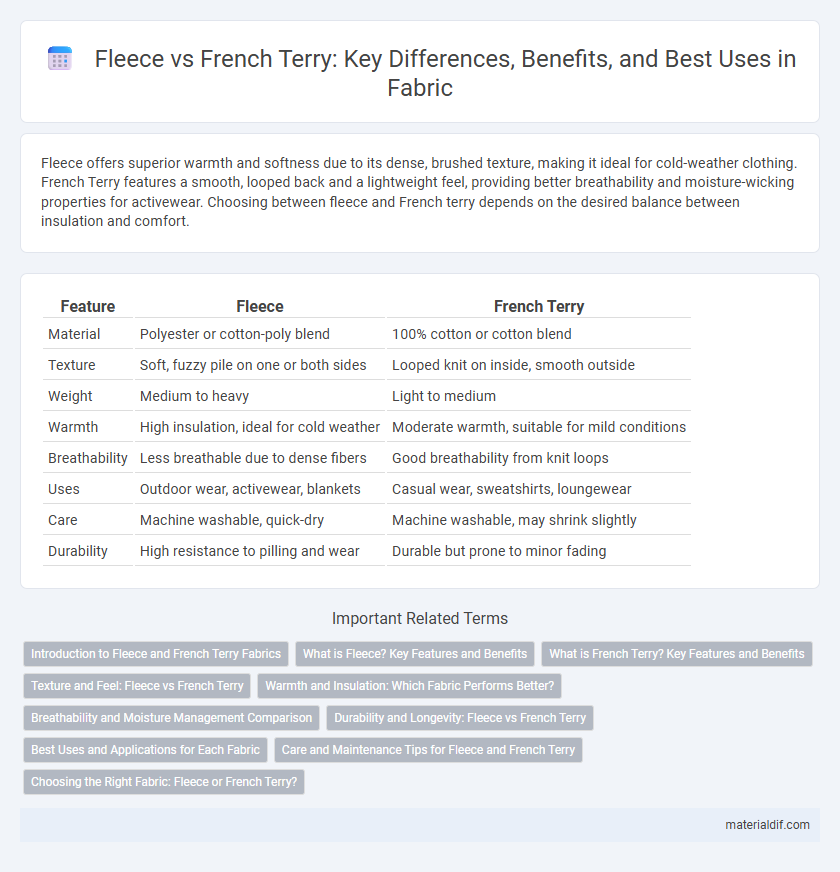Fleece offers superior warmth and softness due to its dense, brushed texture, making it ideal for cold-weather clothing. French Terry features a smooth, looped back and a lightweight feel, providing better breathability and moisture-wicking properties for activewear. Choosing between fleece and French terry depends on the desired balance between insulation and comfort.
Table of Comparison
| Feature | Fleece | French Terry |
|---|---|---|
| Material | Polyester or cotton-poly blend | 100% cotton or cotton blend |
| Texture | Soft, fuzzy pile on one or both sides | Looped knit on inside, smooth outside |
| Weight | Medium to heavy | Light to medium |
| Warmth | High insulation, ideal for cold weather | Moderate warmth, suitable for mild conditions |
| Breathability | Less breathable due to dense fibers | Good breathability from knit loops |
| Uses | Outdoor wear, activewear, blankets | Casual wear, sweatshirts, loungewear |
| Care | Machine washable, quick-dry | Machine washable, may shrink slightly |
| Durability | High resistance to pilling and wear | Durable but prone to minor fading |
Introduction to Fleece and French Terry Fabrics
Fleece is a soft, insulating fabric made from synthetic fibers, commonly polyester, designed for warmth and moisture-wicking in cold weather. French Terry is a knit fabric characterized by a smooth outer surface and looped texture on the inside, offering breathability and moderate insulation ideal for casual wear and activewear. Both fabrics are popular for comfort, with fleece excelling in insulation and French terry favored for lightweight, versatile garments.
What is Fleece? Key Features and Benefits
Fleece is a soft, insulating fabric made from synthetic fibers like polyester, designed to provide exceptional warmth and moisture-wicking properties. Its brushed texture traps heat effectively while remaining lightweight and breathable, making it ideal for cold-weather apparel and activewear. Fleece also offers durability, quick-drying capabilities, and resistance to shrinking, enhancing comfort and long-term wearability.
What is French Terry? Key Features and Benefits
French Terry is a knit fabric characterized by soft loops on one side and a smooth surface on the other, offering excellent moisture-wicking and breathability. Its medium weight and stretch provide comfort and flexibility, making it ideal for activewear and casual clothing. The fabric's durability and easy care contribute to its popularity in both sportswear and everyday apparel.
Texture and Feel: Fleece vs French Terry
Fleece features a plush, soft texture with a brushed interior that provides exceptional warmth and a cozy feel, ideal for cold weather. French Terry offers a smoother surface with looped piles on the inside, delivering a lighter, breathable fabric that balances comfort and moisture absorption. The contrasting textures make fleece inherently warmer and softer, while French Terry excels in flexibility and moisture wicking.
Warmth and Insulation: Which Fabric Performs Better?
Fleece offers superior warmth and insulation compared to French Terry due to its dense, brushed fibers that trap heat effectively, making it ideal for cold weather. French Terry, characterized by its looped inner texture, provides moderate warmth with better breathability, suitable for mild temperatures. Choosing between the two fabrics depends on the desired balance between insulation and ventilation for specific activities or climates.
Breathability and Moisture Management Comparison
Fleece offers superior warmth with moderate breathability, making it ideal for colder, drier conditions but can trap moisture and cause overheating during intense activity. French terry provides enhanced breathability and moisture-wicking capabilities due to its looped knit design, promoting better airflow and quicker drying for activewear and casual garments. Choosing between fleece and French terry depends on the balance needed between insulation and moisture management for specific environmental and activity requirements.
Durability and Longevity: Fleece vs French Terry
Fleece offers superior durability with its dense pile construction that resists pilling and maintains insulation after repeated washes. French Terry, made from looped knit fabric, provides a softer hand feel but can wear down faster with frequent abrasion, showing signs of thinning over time. Choosing fleece ensures longer-lasting warmth and fabric integrity, ideal for activewear and cold-weather garments.
Best Uses and Applications for Each Fabric
Fleece is best suited for outdoor apparel and activewear due to its insulating properties and moisture-wicking capabilities, making it ideal for cold-weather activities and casual wear. French Terry's breathable, lightweight knit with loops on one side excels in casual apparel such as sweatshirts, loungewear, and lightweight jackets, providing comfort without excessive warmth. Both fabrics serve different purposes: fleece for warmth and performance, French Terry for comfort and versatility in moderate climates.
Care and Maintenance Tips for Fleece and French Terry
Fleece requires gentle washing in cold water and air drying to preserve its insulating properties, while avoiding fabric softeners that can damage its texture. French Terry benefits from machine washing in warm water with like colors and tumble drying on low heat to maintain its softness and absorbency. Both fabrics should be stored in a dry environment to prevent mildew and prolonged wear.
Choosing the Right Fabric: Fleece or French Terry?
Fleece and French Terry each offer distinct benefits for different fabric needs; fleece is ideal for warmth and softness due to its thick, plush texture, while French Terry provides a lighter, breathable option with a looped back that enhances moisture-wicking. Choosing the right fabric depends on the intended use--fleece excels in cold weather apparel and cozy loungewear, whereas French Terry suits activewear and transitional seasons. Consider fabric weight, insulation, and moisture management to determine whether fleece or French Terry best matches your comfort and performance requirements.
Fleece vs French Terry Infographic

 materialdif.com
materialdif.com